
E-mail: font@focusonnature.com
Phone: Toll-free in USA 1-888-721-3555
or 302/529-1876
 |
PO Box 9021,
Wilmington, DE 19809, USA E-mail: font@focusonnature.com Phone: Toll-free in USA 1-888-721-3555 or 302/529-1876 |
Highlights
FROM some PREVIOUS
FOCUS ON NATURE TOURS
in MEXICO
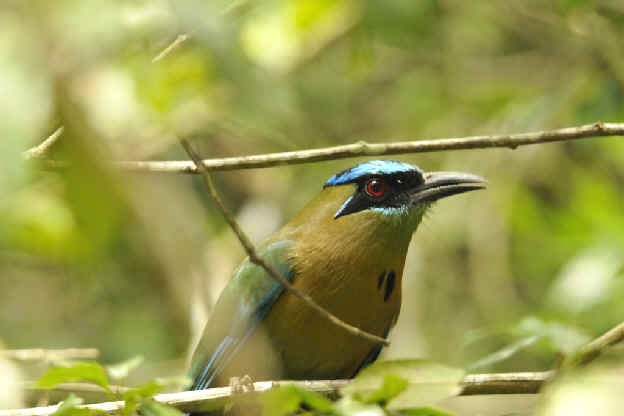
Blue-crowned Motmot
(photo by Marie Grenouillet)
The
tour summaries here are with the most-recent tours first.
For some tours there are links below for longer narratives. Also there are links
to UPCOMING TOUR ITINERARIES, and lists (some with photos) of BIRDS,
BUTTERFLIES, MAMMALS, and OTHER NATURE.
Some Previous tours:
August
2010 March
2009 January 2009
November
2008 September
2008 June 2008
In all, there have been 12
FONT birding & nature tours in Mexico.
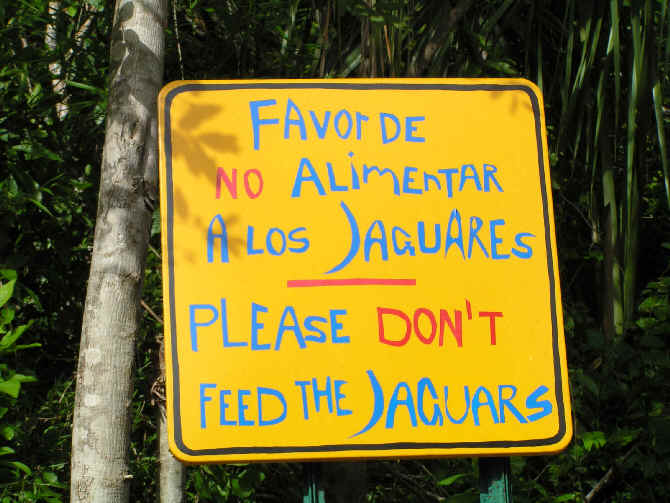
No, we didn't feed any Jaguars
during our March 2009 Mexico Tour,
but we did see one - as we did
during our previous tour in November 2008.
(photo during a FONT tour by Irene Goverts)
Links:
A List &
Photo Gallery of Mexican Birds, in 3 parts:
Part
#1: Tinamous to Shorebirds
Part #2: Jaegers to Woodpeckers
Part #3: Manakins to
Buntings
Mexican Mammals (with some photos) Mexican Butterflies (with some photos)
Mexican Amphibians & Reptiles (with some
photos) Marine Life of the Yucatan (with some
photos)
Upcoming
FONT Birding & Nature Tours in Mexico & Central America
![]()
Mexico, in the northern state of Sonora
August 2010
During the last
week of August 2010, this tours was mostly in two areas in the
northern Mexican state of Sonora.
One area was inland, in remote hills just west of the mountains known as the Sierra
Madre, at a ranch where we've stayed in the past.
Many Ocotillos were among the plants covered those hills, and in which of
course there were birds of various kinds. In canyons, birds included Rufous-capped
Warblers (we saw 3 at once) and Elegant Trogon.
Mammals included the big Antelope Jackrabbits that we saw,
and the Coyotes that we heard. There were more butterflies than
imaginable. And after the sun set, as we were no where near any populated area,
the stars in the sky above seemed to jump out at us.
The other particular area that we visited during this tour in Sonora
was a place along the Gulf of California
(also known as the Sea of Cortez). That
place, a great place for birds, was Kino Bay
(also called, in Spanish, Bahia de Kino).
It's a great place for birds as there are so many, with a large number of
species, and some of them were in large numbers. Notable among
the birds, for us, were both Blue-footed and Brown Boobies, Yellow-footed
and Heermann's Gulls, and Black Storm Petrels.
During one boat-ride, offshore, we circled and then visited an island where
there were only birds, thousands of them. And shells, and other
remnants of life washed up from the sea such as a whalebone, a head of a shark,
and the skull of a parrotfish. Swarms of Magnificent Frigatebirds were in
the air (at least a couple thousand). Around the periphery of the rocky island,
there were thousands of gulls, pelicans, and cormorants, and some shorebirds.
On the cliffs, and on the water and in the air nearby, there were the boobies.
The other boat-ride was on the large estuary, where again birds were in the
thousands. Among them, there were many godwits and curlews, sandpipers,
and long-legged waders of various sorts. In that area of Kino
Bay, during one afternoon, we saw as many as 7 species of terns.
It was so nice to see so much during our time by the sea.
Links:
Birds & Other Wildlife during our tours in Arizona, USA & Sonora, Mexico in Aug/Sep 2010
Photos from the FONT Arizona & Sonora, Mexico Tours in Aug/Sep 2010
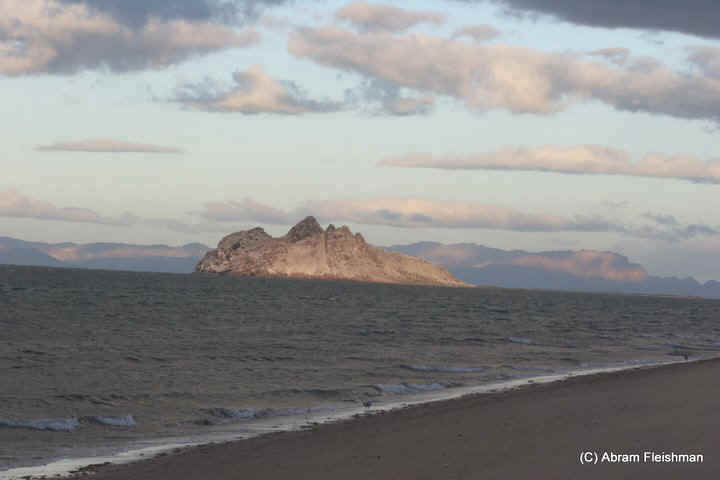
Above: The
island called Alcatraz (or "Pelican")
that we visited when we went to the Sea of Cortez
during our August 2010 tour in Sonora, Mexico.
At the island, in addition to the many pelicans,
we saw both Blue-footed and Brown Boobies,
and swarms of Magnificent Frigatebirds,
Double-crested Cormorants, and Yellow-footed Gulls.
(photo by Abram Fleishman)
![]()
Mexico,
mostly the Yucatan Peninsula, & Cozumel Island
March 2009
This was the third
FONT tour in the Yucatan region of Mexico in
less than a year. The previous two were in June &
November of 2008.
Each of these tours were actually quite different, in terms of the seasons and
the birds & other nature found. March
was much drier than either June or November. There was less song, by the
resident birds, in March than there had been
in June. And, of course, both in November & March,
the bird population was augmented by migrants that breed in North America. Those
in our group, who wouldn't normally see many warblers in the summer where
they live, were certainly treated to many of those colorful birds during the
tour. One person tallied 50 during a very short roadside walk in mangrove
and scrub habitat, with all at his eye-level or lower. Many were Northern
Parulas, with not one of them giving the "warbler neck" a birder
can often get when observing that small species high in a tree!
Some birds were seen during the March 2009
tour that were not found previously in June & November '08. Especially
notable among them were Pinnated Bittern and King Vulture. Both
were seen well, in a scope, by everyone in the group.
Two notable hummingbirds were seen during the tour: the beautiful Cozumel
Emerald (endemic to the offshore island of Cozumel) and the Mexican
Sheartail (a rare bird also with a limited range, in the Yucatan along
the coast). During the month of March, as to the Sheartail, we were
able to see not only the distinctive male, but also a female on the nest - as
well as another nest in which there were some very tiny eggs.
In all, 245 species of birds, of a fine mix, were found during our March
2009 Mexico Tour. (Click the link above for the complete list.)
And the mammals & other wildlife, during the tour, were good
too - actually more than good because once again, as during our
November 2008 tour, A JAGUAR WAS SEEN - as it was on a road at night, in
a forested area of southern Mexico!
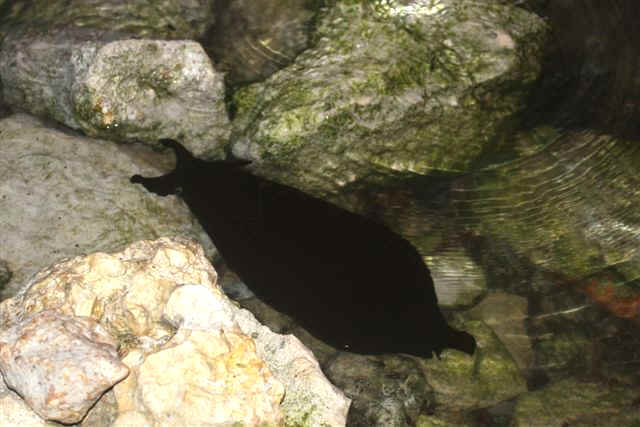
This odd
creature was seen in the water of a coastal bay
from the shoreline in the northern Yucatan,
after dark, during the FONT Mexico tour in March 2009.
In English, it's called the Atlantic Black Sea Hare.
Its scientific name is Aplysia morio.
In Spanish, it's a "Tinta", so called because it ejects ink when
disturbed.
The word "tinta" in Spanish means "ink".
The creature, 16 inches long, and 14 inches across,
is in the Phylum Mollusca (the Molluscs),
and in the Class Bivalva (Bivalves) as are other things such as
the Common Periwinkle, the Slipper Limpet, and the Green Ormer.
The Sea Hare swims in the direction of its "two-pronged head",
in other words, toward the upper left of the photo.
(photo by Marie Gardner)
Links:
Birds & Other Wildlife during our Mexico Tour in March 2009
Birds of the Yucatan Region of Mexico
Photos of Nature
& Culture from the FONT March 2009 Tour in the Yucatan of Mexico
Upcoming FONT Birding & Nature Tours in Mexico & Central America
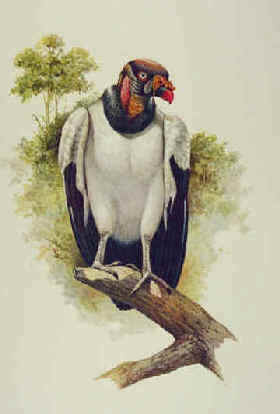
An adult King Vulture was one
of the highlights of our March 2009 tour in southern Mexico.
When it was perched on a large tree branch, everyone observed it through a
scope.
Later, at the end of the tour, when the 10 participants voted for their
"top birds", it was Number #1.
At the end of this 10-day tour, the participants voted for their "top 10 birds", and following below is the composite-list of that vote. 10 people voted, and 43 birds received votes, out of the 245 species found during the tour.
1 - KING VULTURE
2 - Mexican Sheartail
3 - Ferruginous Pygmy Owl
4 - Pinnated Bittern
5 - American Pygmy Kingfisher
6 - Yucatan Jay
7 - Bat Falcon
8 - American Flamingo
9 - Red-crowned Ant Tanager
10 - Ocellated Turkey
11 - Yucatan (or Black-throated) Bobwhite
12 - Gartered (or "Violaceous") Trogon
13 - Lesser Roadrunner
14 - Black-headed Trogon
15 - Keel-billed Toucan
16 - Cozumel Vireo
17 - Squirrel Cuckoo
18 - Pale-billed Woodpecker
19 - Blue Bunting
20 - Painted Bunting
21 - Crane Hawk
22 - Laughing Falcon
23 - Gray-throated Chat
24 - White-tailed Kite
25 - Bare-throated Tiger Heron
26 - Wilson's Plover
27 - Cozumel Emerald
28 - Rufous-browed Peppershrike
29 - Red-throated Ant Tanager
30 - Eye-ringed Flatbill
31 - "Golden" Yellow Warbler
32 - Hooded Warbler
33 - American Redstart
34 - Black Catbird
35 - Crimson-collared Tanager
36 - Barred Antshrike
37 - Dusky Antbird
38 - Yucatan Wren
39 - Black-bellied Whistling Duck
40 - Black-cowled Oriole
41 - Orchard Oriole
42 - Great Black Hawk
43 - Ridgway's Rough-winged Swallow
The last of these was actually the last of the birds to be found during the
tour. A pair, that appeared to be quite territorial, was found on a projecting
ornament up near the ceiling INSIDE a shopping mall at Tulum, as we stopped for
a snack and some gift and souvenir shopping on the way to the hotel by the
airport!
![]()
Mexico,
in the northern state of Sonora
January 2009
The Mexican portion
of this Mexico/Arizona Tour, January 15-24, 2009,
was in the state of Sonora,
where we saw hundreds (actually thousands) of birds of various sorts
along the coast of the Sea of Cortez (also
called the Gulf of California), and
where in the rugged hilly interior of the state, some of the "good
birds" were 2 with the same adjective, the Elegant Quail and the Elegant
Trogon, in addition to the Black-capped Gnatcatcher, Bendire's Thrasher, Streak-backed
Oriole, and the largest of the subspecies of the Wild Turkey, known
as the "Gould's Turkey".
It was a great tour for January (the weather was superb!), and a first
for us at that time of year.
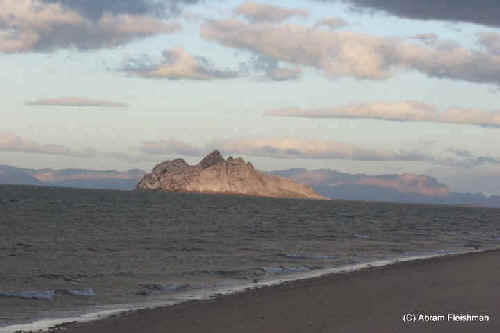
Above: The
island called Alcatraz (or "Pelican")
that we visited when we went to the Sea of Cortez
during our January 2009 tour in Sonora, Mexico.
Below: The race of the Brown Pelican that occurs
at that island is Pelecanus occidentalis californicus,
which has a bright red gular pouch in breeding plumage.
(photos by Abram Fleishman)
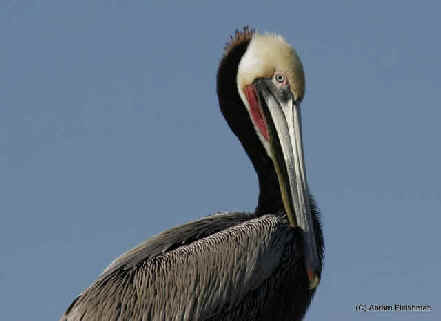
Links:
Birds & Other Wildlife during our tours in Arizona, USA & Sonora,
Mexico in January 2009
To
Top of Page
![]()
Mexico, on the Yucatan Peninsula
November 2008
This was a tour in Mexico
with two "J"s - and with both of them during the same day: a Jabiru
& a Jaguar.
That morning, we saw closely a single Jabiru (it's a rare bird in
Mexico).
Later that day, at dusk, we saw a Jaguar. It too was close, during our 5
minutes of observing it ahead of us on the road in the forest, becoming even
more so, as the big cat walked, with its steady pace, to be immediately in front
of our vehicle. There it was seen at every angle as it turned to cross the road,
and then walked away a short bit before disappearing into the trees.
Another highlight of the tour was a beautiful Rufescent (or Thicket)
Tinamou that walked, with its determined pace, right by us, as we were on
the lower steps of a Mayan temple.
And yet another highlight was by yet another remote Mayan temple in the forest -
an Orange-breasted Falcon.
At the opposite (or northern) end of the Yucatan
Peninsula, during one day we saw thousands of birds. Over
20,000 of them were American Flamingos. Others, in the multitude that day
included thousands more of other kinds, with the assortment consisting of
waterbirds, shorebirds, and some landbirds too. Notable among the
last of these groups was a single hummingbird, known as the Mexican
Sheartail - a rare bird with a very restricted range that's actually only
about a kilometer wide.
Among the waterbirds, there were hundreds of American White Pelicans,
with many feeding in unison on the water of the bay. The number of shorebirds
were more than imaginable. In swarms, all around us, most were Lesser
Yellowlegs, Least Sandpipers, other peeps, and Sanderlings.
But there were others too, including a variety of Plovers: Snowy, Piping,
Wilson's, Semipalmated, and Black-bellied.
In the central Yucatan, a fascinating experience for us was in the "other
nature" category. Underground, in a pool of clear water in a cave, we
saw, with our flashlights, some Yucatanian endemic creatures that could never
see us. In that dark world, there were these, all-white: a fish, an eel,
and a shrimp, that do not have eyes!
Links:
Birds & Other Wildlife during our Mexico Tour - November 2008
Birds of the Yucatan Region of Mexico
![]()
Mexico,
in the northern state of Sonora
September 2008
"The
FONT Birding & Nature Tour in southern Arizona
& northern Mexico in Aug/Sep '08"
During
the first part of this tour, in ARIZONA, a
bird, normally of Mexico, was seen and heard. That bird, a first for the United
States, was the Sinola Wren (formerly known as the Bar-vented
Wren). Its new name is that of a Mexican state, located south of the
more-northerly Mexican state of Sonora, which borders on Arizona.
During the second part of this tour, we were, during 3 days, in SONORA,
MEXICO, where, at a remote ranch, we birded and explored in some of
the most pristine countryside imaginable. Among our "Mexican" bird
species there, in addition to another Sinola Wren, there was, in the
riparian plants at the base of a magnificent canyon, the Rufous-capped
Warbler.
During the ARIZONA portion of the tour, as usual as during our previous tours,
we enjoyed a wonderful assortment of Hummingbirds, including a couple
species that are more common in Mexico, the White-eared, the
Violet-crowned, and the Lucifer.
In addition to birds, during this tour, there was a fine assortment of butterflies,
mammals, and reptiles.
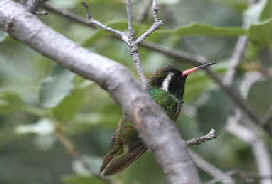
White-eared Hummingbird
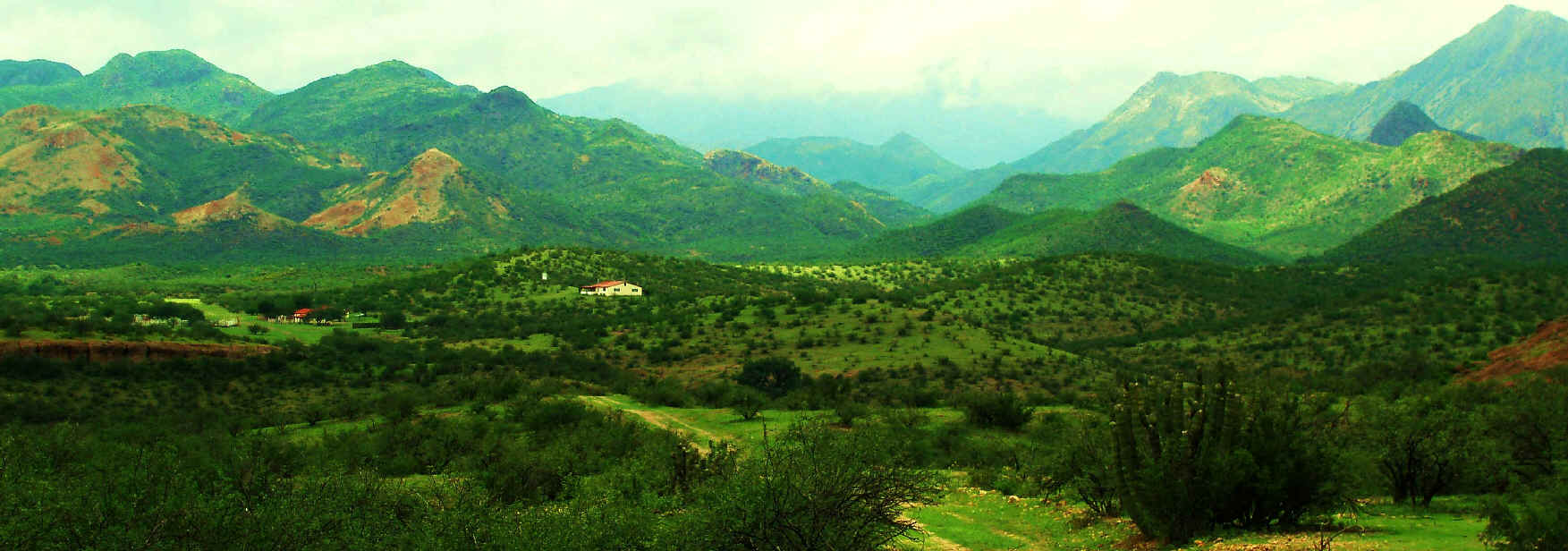
It was in the building
on the hill with the red roof
where we stayed during our days & nights
in remote eastern Sonora in northern Mexico
during our tour in September 2008.
Birds in the area included: Montezuma and
Elegant Quails,
Zone-tailed Hawk, Rose-throated Becard,
Sinaloa Wren, Rufous-capped Warbler,
Mexican Yellow Grosbeak, Five-striped Sparrow,
and both Rufous-winged &
Rufous-crowned Sparrows.
Pumas
are said to be common in the area as are
White-nosed Coatis &
Collared Peccaries.
We saw a number of Coue's White-tailed Deer,
Antelope Jackrabbits,
and various bats.
Early in the mornings, Coyotes
howled close to where we stayed,
actually just outside our windows.
At dusk, Common Poorwills
called, even though it was early September.
After dark, in the completely-clear sky, there was a superb show
of stars & planets,
with a brilliant Milky Way
that stretched from nearly horizon to horizon.
A couple very bright "falling
stars" were also in the
cast of celestial characters.
This was as some Elf Owls
called, even though, again,
it was September.
Following
the Arizona tour, in September
'08, we
crossed the border from the
We headed toward a place that was to be special to us, for the birds
and the other nature that we would experience there. It's the property of a
large ranch, about 30,000 acres, in the
Wildlife does abound in the area. Pumas are said to be common.
Deer and Coyote are as well. Many birds occur. During our
tour, both Montezuma and Elegant Quail were found. In one of the
canyons, we found Rufous-capped Warblers. A Mexican Yellow Grosbeak was
seen, as were Five-striped and Rufous-winged Sparrows. The last of
these species can be seen locally in southern
In all, we saw a good number of birds, of about 70 species, on and near the
property of the ranch.
What probably is best about where we were in the remote hills of Sonora is that
it IS NOW, as places such as Arizona WERE in the past - before the
"development" brought highways, agriculture, and many people. On the
property in
Oh, there are some cattle on the ranch, but not many. As one traveled about on
the property on tracks in a four-wheel drive vehicle, one had the opportunity to
sense, during our visit, what a "natural place" could really be like -
and how it was before the highways, agriculture, and many people.
I thought, more than once, as I was in those Sonoran hills, that a place in the
There are a lot of birds and other nature in those
At one point, as we were driving, we noted a huge flock of birds kettling in the
sky, hundreds of them, maybe a thousand. A look in the binoculars showed them to
be Ravens.
Also in the region, numerous birds occur at
To give again an idea of how remote and wild the area we visited in
As we stood on a hill overlooking
In a nearby canyon, with steep walls, a couple years ago, a pair of Military
Macaws were seen - the most northern sighting of that species, and the
closest to the US.
Referring back to Geronimo for a second, one of the reasons why this part of
During our tour on the Sonoran ranch, our early-morning wake-up call, just
outside our windows, was the howling of Coyotes. Throughout the day,
there were, as noted, many birds, and also, butterflies in numbers of fine
variety, and animals such as the Antelope Jackrabbit and the Coue's
White-tailed Deer. Following dusk, owls called. After dark, the stars
shone brightly, including a Milky Way that nearly jumped out at us.
As wonderful as the area and the nature were, it was without a doubt, all
the more so, due to the kind hospitality of our hosts, Manuel and his family,
and David. We learned so much from them, and our excellent Mexican meals on the
ranch, reminded us, even though we didnít need reminding, of where we were.
All of the time, during our visit, we were, simply put, so very glad to be
there.
![]()
Mexico,
mostly the Yucatan Peninsula, & Cozumel Island
June 2008
This tour, as
noted, was mostly on the Yucatan Peninsula,
and also on Cozumel Island, 12 miles
offshore. We say "mostly on the Yucatan Peninsula" as we also went
further south, into remote areas, quite wild, close to the Mexican borders with
Guatemala and Belize. Most notable of those areas was Calakmul.
Not only a remote, not often visited, site of Mayan ruins, comparable to Tikal
in Guatemala, Calakmul is vast reserve known as a biosphere. Standing atop the
highest temple there one sees as far as the horizon in all directions only a sea
of green foliage of forest. Calakmul was one of 4 biospheres that we visited
during our tour, during which we found over 200 species of birds.
And there could have been more as the Yucatan is a bird-rich area. Not only is
it with many different birds (about 540 species cumulatively recorded in 75
families - that's about half of the 100 or species that occur in Mexico),
but the Yucatan has a number of interesting species and subspecies as the
isolated region has evolved, due to a number of factors, to have its own
distinctive flora and fauna. Thus, it has 14 endemic species of birds, and
almost 100 endemic subspecies.
And the bird-life on Cozumel Island is
interesting too, as it has 3 endemic species and about 15 endemic subspecies.
To read about these interesting birds of the Yucatan and
Cozumel, click the link above.
Among our favorite birds of this tour were the endemic Yucatan Wren (the
last of the Yucatan species to be described, in 1934), and the
nearly-endemic Mexican Sheartail. That hummingbird has a very
interesting range. Like the Yucatan, or Black-throated, Bobwhite,
it is restricted to the Yucatan all but for a small isolated population
elsewhere. But on the Yucatan, it only occurs in the north, near the coast,
where its range has only the width of just over a kilometer!
All of the endemics & those nearly-endemics notwithstanding, the bird that
we liked the most during our tour was one with an extensive range in Central
& South America. But we saw it so well! And it stayed - just a few feet from
us. It was the little and brightly-colored American Pygmy Kingfisher, by
a small marsh in the forest in that wild area of Calakmul.
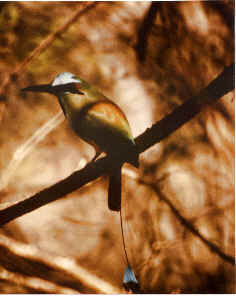
The Mayans called it "TOH".
We know it as the
TURQUOISE-BROWED MOTMOT.
We saw many during our June '08 Mexico Tour.
Links:
More
about the FONT Mexico Tour in June 2008
Birds & Other Wildlife during our Mexico Tour - June 2008
Birds of the Yucatan Region of Mexico
Upcoming FONT Birding & Nature Tours in Mexico & Central America